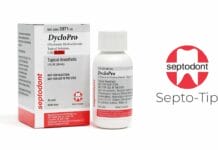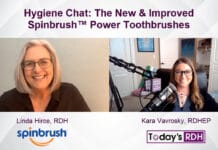1. The Food and Drug Administration (FDA) regulates over-the-counter (OTC) mouthwashes that make therapeutic claims. In addition to data supporting effectiveness which of the following criteria is examined as well?
The FDA evaluates effectiveness as well as safety criteria that include incidence and risk of adverse reactions, the margin of safety with normal use, the potential for harm from abuse or misuse, the potential for inducing adverse side effects, and the benefit-risk ratio. The FDA’s Dental Plaque Subcommittee of the Nonprescription Drug Advisory Committee has classified only two OTC mouthwash ingredients as safe and effective and not misbranded: cetylpyridinium chloride and essential oils.
DePaola, L.G., Eshenaur Spolarich, A. Safety and Efficacy of Antimicrobial Mouthrinses in Clinical Practice. Journal of Dental Hygiene. 2007; 81(5). Retrieved from https://jdh.adha.org/content/jdenthyg/81/suppl_1/117.full.pdf
2. According to the FDA, National Cancer Institute, and the American Dental Association (ADA), there is no evidence of a causal relationship between alcohol-containing mouthwashes and oropharyngeal cancer.
A study published in 1991 has been widely referenced as evidence of a causal link between alcohol-containing mouthwashes and oropharyngeal cancer. A reanalysis of this study by independent reviewers determined that many of the patients included in the study had tumors of mucosal histology, meaning they could not have been caused by alcohol-containing mouthwashes. Additional investigators further confirmed there is no evidence that alcohol-containing mouthwash use increases the risk for oropharyngeal cancer.
DePaola, L.G., Eshenaur Spolarich, A. Safety and Efficacy of Antimicrobial Mouthrinses in Clinical Practice. Journal of Dental Hygiene. 2007; 81(5). Retrieved from https://jdh.adha.org/content/jdenthyg/81/suppl_1/117.full.pdf
3. Are there any long-term benefits to using an antiseptic mouthwash?
A systematic review published in 2007 found that adjunct use of mouthwashes with essential oils provided benefits in reducing plaque and gingivitis when compared to controls. LISTERINE® Antiseptic not only works to immediately begin killing bacteria but also helps to rebalance the oral microbiome over time. The sustained impact of this germ kill helps patients experience sustained reduction in the buildup of plaque and improved gingival health.
Stoeken, J.E., Paraskevas, S., van der Weijden, G.A. (2007). The Long-Term Effect of a Mouthrinse Containing Essential Oils on Dental Plaque and Gingivitis: A Systematic Review. Journal of Periodontology. 2007; 78(7): 1218–1228. doi:10.1902/jop.2007.060269. Retrieved from https://pubmed.ncbi.nlm.nih.gov/17608576/
4. There is sufficient evidence the use of alcohol-containing mouthwashes reduces salivary flow. Therefore, use should be avoided in all patients, even those with normal salivary flow.
Despite assumptions that alcohol-containing mouthwashes cause xerostomia (dry mouth), there are no studies that clearly support this claim, even in patients with normal salivary flow. A preliminary study published in 2015 aiming to “compare measures of dry mouth following extended use of an alcohol-based mouthwash and a non-alcohol-based mouthwash” found the two groups demonstrated comparable objective measures regarding dry mouth.
Kerr, A.R., Corby, P.M., Kalliontzi, K., McGuire, J.A., Charles, C.A. Comparison of Two Mouthrinses in Relation To Salivary Flow and Perceived Dryness. Oral Surg Oral Med Oral Pathol Oral Radiol. 2015; 119(1): 59-64. doi:10.1016/j.oooo.2014.09.027. Retrieved from https://pubmed.ncbi.nlm.nih.gov/25482548/
DePaola, L.G., Eshenaur Spolarich, A. Safety and Efficacy of Antimicrobial Mouthrinses in Clinical Practice. Journal of Dental Hygiene. 2007; 81(5). Retrieved from https://jdh.adha.org/content/jdenthyg/81/suppl_1/117.full.pdf
5. All alcohol-containing mouthwashes contain the same amount of alcohol.
The amount of alcohol in alcohol-containing mouthwashes varies from 6% to 26.9%. Chlorhexidine gluconate generally has 12.6% alcohol, cetylpyridinium chloride mouthwash has between 6% and 18% alcohol, and essential oils mouthwashes contain either 21.6% or 26.9%, depending on flavors.
Kerr, A.R., Corby, P.M., Kalliontzi, K., McGuire, J.A., Charles, C.A. Comparison of Two Mouthrinses in Relation To Salivary Flow and Perceived Dryness. Oral Surg Oral Med Oral Pathol Oral Radiol. 2015; 119(1): 59-64. doi:10.1016/j.oooo.2014.09.027. Retrieved from https://pubmed.ncbi.nlm.nih.gov/25482548/
DePaola, L.G., Eshenaur Spolarich, A. Safety and Efficacy of Antimicrobial Mouthrinses in Clinical Practice. Journal of Dental Hygiene. 2007; 81(5). Retrieved from https://jdh.adha.org/content/jdenthyg/81/suppl_1/117.full.pdf
6. Antimicrobial mouthwashes work by which of the following mechanisms?
Some antimicrobial mouthwashes provide a wide spectrum of activity. Though some antimicrobial mouthwashes are bacteriostatic, most are bactericidal. Different antimicrobial mouthwashes demonstrate different levels of efficacy against multiple microbes, including bacteria, fungi, viruses, and spores. Antimicrobial mouthwashes achieve this efficacy through a chemical agent that eliminates microorganisms through multiple mechanisms, including producing cell death, inhibiting microbial reproduction, and inhibiting cellular metabolism.
DePaola, L.G., Eshenaur Spolarich, A. Safety and Efficacy of Antimicrobial Mouthrinses in Clinical Practice. Journal of Dental Hygiene. 2007; 81(5). Retrieved from https://jdh.adha.org/content/jdenthyg/81/suppl_1/117.full.pdf
7. Has the safety of alcohol-containing mouthwashes been studied extensively?
Numerous studies over the past 40 years have shown that there is no negative impact detected in the use of mouth rinses containing alcohol. LISTERINE® Antiseptic is the most extensively tested OTC mouth rinse globally, and its safety is supported by fifteen 6-month studies conducted over a 20-year period in 3203 subjects.1-10
Additionally, a recent study published in 2021 found “no statistically as well as biologically significant adverse responses of both alcohol-based and alcohol-free mouth rinses at clinical and cytological level.”11
1. Data on file, Johnson & Johnson Consumer Inc.
2. Fischman, S.L., Aguirre, A., Charles, C.H. Use of Essential Oil-containing Mouthrinses by Xerostomic Individuals: Determination of Potential for Oral Mucosal Irritation. Am J Dent. 2004; 17(1): 23-26.
3. Kerr, A.R., Katz, R.W., Ship, J.A. A Comparison of the Effects of 2 Commercially Available Nonprescription Mouthrinses on Salivary Flow Rates and Xerostomia. Quintessence Int. 2007; 38(8): e440-e447.
4. Kerr, A.R., Corby, P.M., Kalliontzi, K., et al. Comparison of Two Mouthrinses in relation to Salivary Flow and Perceived Dryness. Oral Surg Oral Med Oral Pathol Oral Radiol. 2015; 119(1): 59-64.
5. Aceves Argemí, R., González Navarro, B., Ochoa García-Seisdedos, P., et al. Mouthwash with Alcohol and Oral Carcinogenesis: Systematic Review and Meta-analysis. J Evid Based Dent Pract. 2020; 20(2): 101407.
6. International Agency for Research on Cancer (IARC). IARC monographs on the evaluation of carcinogenic risks to humans: Report of the advisory group to recommend priorities for IARC Monographs during 2015-2019. https://monographs.iarc.fr/wp-content/uploads/2018/08/14-002.pdf
7. Food and Drug Administration. Oral health care drug products for over-the-counter human use; antigingivitis/antiplaque drug products; establishment of a monograph; proposed rules. Part Ill. Fed Regist. 2003; 68(103): 32232-32287.
8. Cole, P., Rodu, B., Mathisen, A. Alcohol-containing Mouthwash and Oropharyngeal Cancer: A Review of the Epidemiology. J Am Dent Assoc. 2003; 134(8): 1079-1087.
9. La Vecchia, C. Mouthwash and Oral Cancer Risk: An Update. Oral Oncol. 2009; 45(3): 198-200.
10. Boyle, P., Gandini, S., Boffetta, P., et al. Mouthwash Use and Oral Cancer Risk: Quantitative Meta-analysis of Epidemiologic Studies. Oral Surg Oral Med Oral Pathol Oral Radiol Endod. 2011; 112(6): e130.
11. Gupta, V., Pant, V.A., Pandey, S., Pant, A.B. Efficacy and Safety Evaluation of Alcohol-containing and Alcohol-free Mouth Rinses: A Clinicocytological Study. J Indian Soc Periodontol. 2021; 25(2): 128-132. doi:10.4103/jisp.jisp_196_20. Retrieved from https://www.ncbi.nlm.nih.gov/pmc/articles/PMC8041073/
8. Salivary nitrite production is not markedly inhibited by essential oil mouthwash. However, chlorhexidine at concentrations of 0.12% or 0.2% reduced salivary nitrite drastically.
Nitric oxide produced by the reduction of dietary nitrate by microbial flora is beneficial to vascular health. Concerns have been raised about the possibility that mouthwash may interfere with oral microbial flora and reduce the production of nitric acid, which could contribute to reduced vascular health. However, a study published in 2016 found essential oil mouthwash had little effect on nitrate-reducing activity and the count of V. dispar an oral bacterium known to reduce nitrate to nitric oxide.
Mitsui, T., Harasawa, R. The Effects of Essential Oil, Povidone-iodine, and Chlorhexidine Mouthwash on Salivary Nitrate/nitrite and Nitrate-reducing Bacteria. J Oral Sci. 2017; 59(4): 597-601. doi:10.2334/josnusd.16-0593. Retrieved from https://www.jstage.jst.go.jp/article/josnusd/59/4/59_16-0593/_pdf/-char/en
9. Which of the following is the general combination of phenolic essential oils found in essential oil mouthwashes?
The combination of phenolic essential oils, eucalyptol, menthol, methyl salicylate, and thymol work by the following mechanisms:
- Protein denaturation
- Alteration of the cell membrane
- Alteration of bacterial enzyme activity
- Inhibition of prostaglandin synthetase (anti-inflammatory mechanism of action)
- Perforation of the cell membrane
- Alter neutrophil function reducing free radicals
These mechanisms of action start working after a 30-second exposure to the essential oil mouthwash.
DePaola, L.G., Eshenaur Spolarich, A. Safety and Efficacy of Antimicrobial Mouthrinses in Clinical Practice. Journal of Dental Hygiene. 2007; 81(5). Retrieved from https://jdh.adha.org/content/jdenthyg/81/suppl_1/117.full.pdf
Unlike other OTC mouthwashes, essential oil has been shown to penetrate the dental plaque biofilm and is active against bacteria found embedded in the biofilm. Evidence shows it kills both aerobic and anaerobic bacteria associated with plaque biofilm and gingivitis.
Essential oil mouthwash can penetrate dental plaque biofilm and reach bacteria embedded within the biofilm. Essential oils kill a wide variety of anaerobic and aerobic bacteria including, A. actinomycetemcomitans, A. viscosus, S. mutans, S. sanguis, and Bacteroides species. Additionally, essential oil mouthwashes have been shown to “extract endotoxins from gram-negative bacteria.” Considering endotoxins play a huge role in pathogenesis, the reduction should also contribute to a decrease in gingival inflammation.
DePaola, L.G., Eshenaur Spolarich, A. Safety and Efficacy of Antimicrobial Mouthrinses in Clinical Practice. Journal of Dental Hygiene. 2007; 81(5). Retrieved from https://jdh.adha.org/content/jdenthyg/81/suppl_1/117.full.pdf








